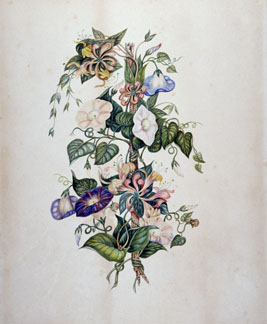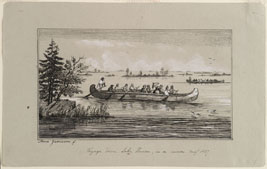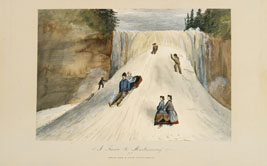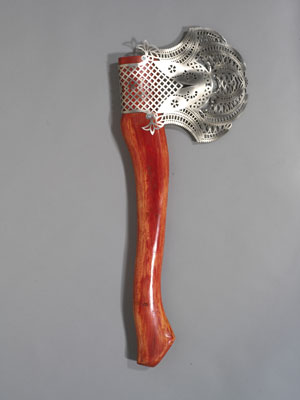Brushing It in the Rough: Women, Art and Nineteenth Century Canada
Published
Category
Press Release

Dr. Arlene Gehmacher, Curator of Canadian Paintings, Prints & Drawings in the ROM’s World Cultures department is the exhibition’s curator. She says, “The exhibition’s title is a play on “Roughing it in the Bush,” the title of Susanna Moodie’s disparaging account of her early years in Upper Canada. The works featured in this exhibition were not executed in the backwoods, nor were they all done by brush. The spoonerism (wordplay) creates a metaphor for the challenges women encountered in nineteenth-century Canada, and, perhaps more significantly, their strategies in dealing with such difficulties through the production of art.
Anna Jameson (Irish, 1794 – 1860)
Already a respected author in England, Anna Jameson arrived in Toronto in December 1836 to join her husband, the Attorney General of Upper Canada. The season was bleak as 
Anna Jameson produced more than 50 drawings of her Canadian experience and a number of the drawings were the basis for etchings, also executed by Jameson. These include the five on display in Brushing it in the Rough. While these were likely intended for her publication, ultimately no images were included. Jameson’s approach to her subjects ranges from observer to participant, occasionally inserting herself into the scene. While Jameson’s desolate “Winter Journey from Niagara by Lake Ontario” may be interpreted as a metaphor for her own early despondency, then “Voyage Down Lake Huron in a Canoe” might reference her “escape”.
Susanna Moodie (English, 1803 – 1885)
Born of a middle class family, Susanna Moodie immigrated to Upper Canada in 1832 as the wife of a retired English army officer. First living in the backwoods, after eight years of farming their land, they moved to “civilization” upon her husband’s appointment as sheriff. The comparatively urban environment of Belleville allowed Moodie to focus on writing. Eventually becoming a staple of Canadian literature, her “Roughing it in the Bush” (1852) recalled the harshness of her backwoods years.
Susanna Moodie apparently took up watercolour painting later in life and the 1860s were a time to develop her skills in the medium. Focused mainly on floral still lifes, she painted from life, also finding inspiration in botanical prints. It is unclear as to why Moodie took up painting floral images but it may have been an attempt to diminish memories of her early years of hardship. Ironically, while painting appears to have been originally a leisure activity for Moodie, it soon became economically necessary. Moodie sold her works to raise household money with her watercolours eventually commanding five dollars each.
Alice Killaly (Canadian, 1836 – 1908) 
Alice Killaly was born in London, Ontario but lived in a number of towns in Upper and Lower Canada. Given the quality of her signed watercolour landscapes, she likely had formal art education and it is thought that Cornelius Krieghoff may have been her teacher. Killaly’s first attempt, in 1868, at having her artistic talents formalized as part of a business venture was also her last as she moved to England shortly after marrying in 1870.
Alice Killaly’s “A Picnic to Montmorenci” (1868) is a set of six chromolithographs recounting an outing to one of Quebec’s most beloved tourist attractions. The title is both realist and ironic. While picnics were enjoyed during the winter at Montmorency Falls, Killaly’s take on the subject is filled with humour. Two young people, the hapless “Buzbie” and the non-plussed “Miss Muffin” are seen engaging in the ritual of courting. At the time, advertisements touted the set as the “first of its kind” making the most of its Canadian subject, humour, artist (including Killaly’s gender), printer and publisher. The process behind chromolithography could, but need not, involve the artist. While Killaly provided the original artwork, as she lived in Toronto and the set was printed in Montreal, it is unlikely that she reproduced the images on the lithographic plate.
Ruth Abernethy (Canadian, 1960 -)

The “Canadiana” series is an exploration of settlement life through the tools, implements, and craftwork used to shape Canada. Each object broadly suggests the pioneers’ quest for “civilization,” while also pointedly addressing the role of women in building community. References to handiwork, such as tatting and lace patterns, typically seen as “female” transform items conventionally evocative of men’s labour – a hatchet, hammer, or cross-cut saw. In feminizing typically “male” implements, Abernethy reinserts the presence of women into the story of settlement. In combining national symbols with typically female work, she makes the case for the essential role of women in building community.


